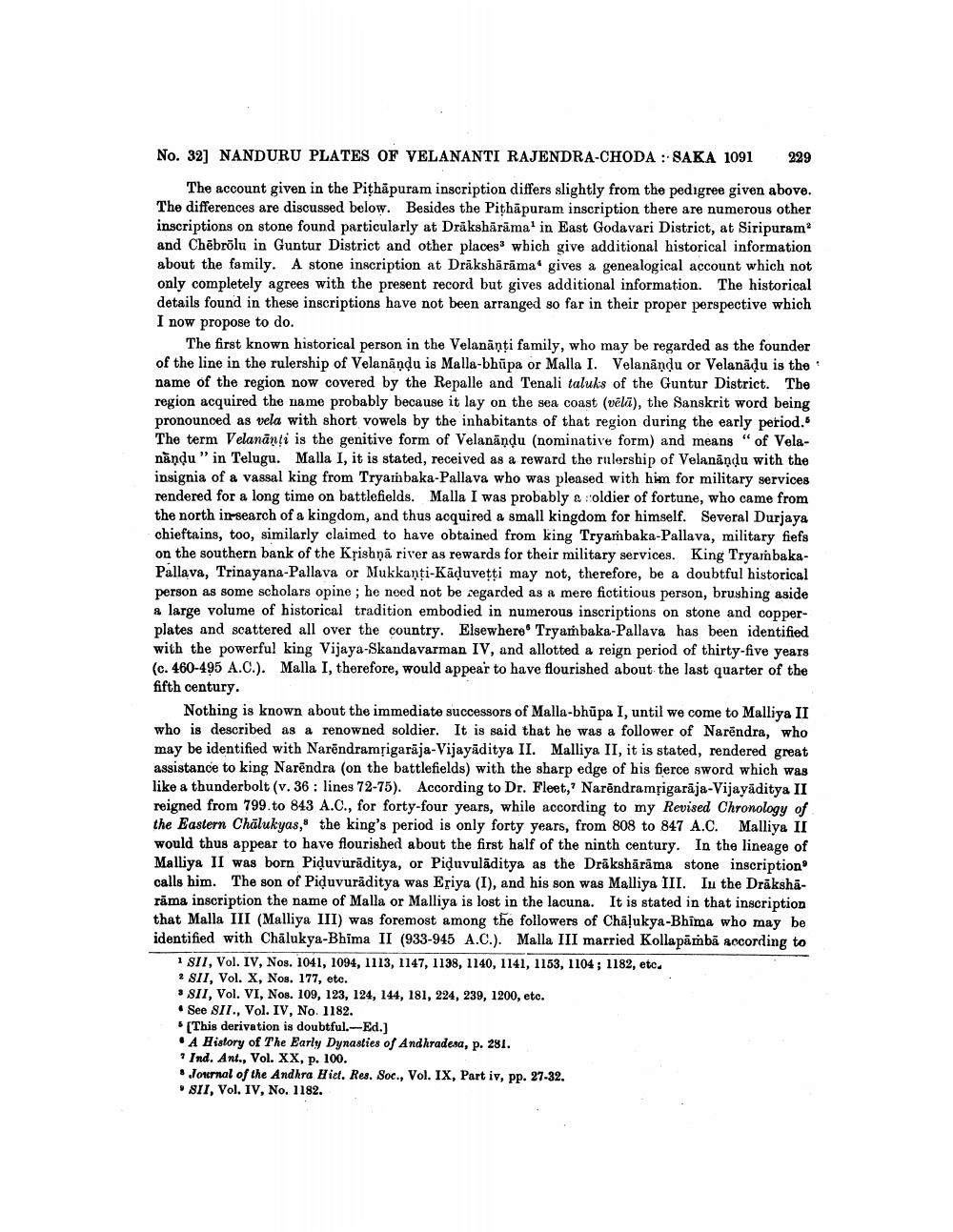________________
No. 32] NANDURU PLATES OF VELANANTI RAJENDRA-CHODA : SAKA 1091
229
The account given in the Pithapuram inscription differs slightly from the pedigree given above. The differences are discussed below. Besides the Pithāpuram inscription there are numerous other inscriptions on stone found particularly at Drākshārāma' in East Godavari District, at Siripuram and Chēbrölu in Guntur District and other places which give additional historical information about the family. A stone inscription at Drākshārāma. gives a genealogical account which not only completely agrees with the present record but gives additional information. The historical details found in these inscriptions have not been arranged so far in their proper perspective which I now propose to do.
The first known historical person in the Velanāņti family, who may be regarded as the founder of the line in the rulership of Velanāņdu is Malla-bhūpa or Malla I. Velanändu or Velanādu is the name of the region now covered by the Repalle and Tenali taluks of the Guntur District. The region acquired the name probably because it lay on the sea coast (vēlā), the Sanskrit word being pronounced as vela with short vowels by the inhabitants of that region during the early period. The term Velanānti is the genitive form of Velanāņdu (nominative form) and means “ of Velanàndu " in Telugu. Malla I, it is stated, received as a reward the rulership of Velanāndu with the insignia of a vassal king from Tryambaka-Pallava who was pleased with him for military services rendered for a long time on battlefields. Malla I was probably & soldier of fortune, who came from the north irrsearch of a kingdom, and thus acquired a small kingdom for himself. Several Durjaya chieftains, too, similarly claimed to have obtained from king Tryambaka-Pallava, military fiefs on the southern bank of the Krishņā river as rewards for their military services. King TryambakaPallava, Trinayana-Pallava or Mukkanti-Kāduvetti may not, therefore, be a doubtful historical person as some scholars opine; he need not be regarded as a mere fictitious person, brushing aside a large volume of historical tradition embodied in numerous inscriptions on stone and copperplates and scattered all over the country. Elsewhere. Tryambaka-Pallava has been identified with the powerful king Vijaya-Skandavarman IV, and allotted a reign period of thirty-five years (c. 460-495 A.C.). Malla I, therefore, would appear to have flourished about the last quarter of the fifth century.
Nothing is known about the immediate successors of Malla-bhūpa I, until we come to Malliya II who is described as a renowned soldier. It is said that he was a follower of Narendra, who may be identified with Narēndramrigarāja-Vijayāditya II. Malliya II, it is stated, rendered great assistance to king Narendra (on the battlefields) with the sharp edge of his fierce sword which was like a thunderbolt (v. 36 : lines 72-75). According to Dr. Fleet,? Narēndramţigarāja-Vijayāditya II reigned from 799.to 843 A.C., for forty-four years, while according to my Revised Chronology of the Eastern Chälukyas," the king's period is only forty years, from 808 to 847 A.C. Malliya II would thus appear to have flourished about the first half of the ninth century. In the lineage of Malliya II was born Piduvurāditya, or Piduvulāditya as the Drākshärama stone inscription calls him. The son of Piduvurăditya was Eriya (I), and his son was Malliya III. Iu the Dräksharāma inscription the name of Malla or Malliya is lost in the lacuna. It is stated in that inscription that Malla III (Malliya III) was foremost among the followers of Chāļukya-Bhima who may be identified with Chalukya-Bhima II (933-945 A.C.). Malla III married Kollapāmbă socording to
1 811, Vol. IV, Nos. 1041, 1094, 1113, 1147, 1138, 1140, 1141, 1153, 1104; 1182, etc. ? SII, Vol. X, Nos. 177, etc. : SI1, Vol. VI, Nos. 109, 123, 124, 144, 181, 224, 239, 1200, etc. • See SI1., Vol. IV, No. 1182.
[This derivation is doubtful.-Ed.] • A History of The Early Dynasties of Andhradesa, p. 281. Ind. Ant., Vol. XX, p. 100. Journal of the Andhra Hiet. Res. Soc., Vol. IX, Part iv, pp. 27-32. SIT, Vol. IV, No. 1182.




